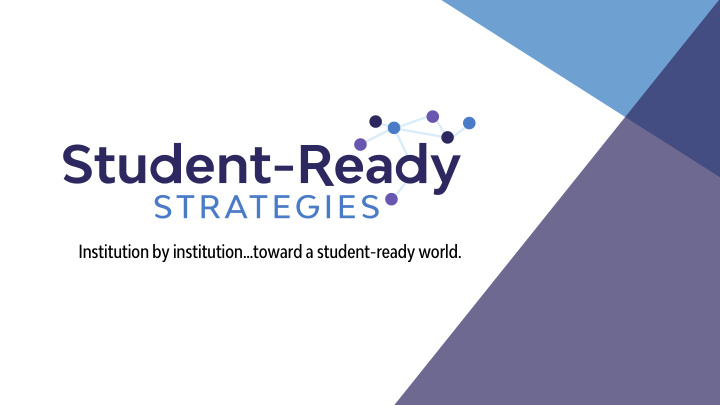



Institution by institution…toward a student-ready world.
Our Cornerstone Belief All students can succeed. We reject any exceptions to this statement. Not exceptions based on race, age, disability status, economic circumstances, parents’ education level, academic preparation, social preparedness, or any other factor.
Our Vision A world in which colleges and universities believe all students can succeed and purposely evolve to ensure they do. Our Mission To partner, plan and problem-solve with colleges and universities as they evolve to ensure the success of diverse students with complex lives… Institution by institution, toward a student-ready world.
How do we achieve attainment goals? o Graduate more of the students we have o Close achievement gaps o Redefine and expand the pipeline of entering students
National graduation rates: 4-year institutions Graduation rates from first institution attended for first-time, full-time bachelor’s degree-seeking students at 4-year postsecondary institutions, by race/ethnicity and time to completion: Cohort entry year 2010 U.S. Department of Education, National Center for Education Statistics, Integrated Postsecondary Education Data System (IPEDS), Winter 2016–17, Graduation Rates component. See Digest of Education Statistics 2017, table 326.10.
National 3-year graduation rates: 2-year institutions Graduation rate within 150 percent of normal time for degree completion from first institution attended for first-time, full-time associate’s degree/certificate-seeking students at 2-year postsecondary institutions, by race/ethnicity: Cohort entry year 2013 U.S. Department of Education, National Center for Education Statistics, Integrated Postsecondary Education Data System (IPEDS), Winter 2016–17, Graduation Rates component. See Digest of Education Statistics 2017, table 326.20.
How many DID NOT graduate? 70% 68% 77% 70% 73% 75% 64% 73% U.S. Department of Education, National Center for Education Statistics, Integrated Postsecondary Education Data System (IPEDS), Winter 2016–17, Graduation Rates component. See Digest of Education Statistics 2017, table 326.20.
“T “Too many of us s are begi ginning g to abso solve ou ours rselves from rom re respons onsibility y assoc ociated with poor stud wi udent out utcomes. We place bl blame on either the indi dividua dual stude udent, the K-12 12 system, , or broader societal l ch challenges.” Tia Brown McNair, Susan Albertine, Michelle Asha Cooper, Nicole McDonald and Thomas Major, Jr. Becoming a Student Ready College: A New Culture of Leadership for Student Success
“Every system is perfectly designed to get the results it does.” -W Edward Deming
Expe Expectati tations • What percentage of part-time students in their 2 nd college term say they expect to earn an associate degree 1-2 years from entry? 47% The Center for Community College Student Engagement: Even One Semester: Full-Time Enrollment and Student Success (2017).
Cost Cost • What is the cost difference between a 2-year associate degree and a 6-year associate degree? $560,000 https://www.nerdwallet.com/blog/loans/student-loans/victory-lap /
Suc Success ss • What percentage of always part-time students graduate after six years? 20%
6-Year Graduation Rates Year Graduation Rates 90% 80.1% 80% 80% 70% 60% 50% 39.5% 40% 40% 30% 20.4% 20% 20% 10% 0% Always Part-Time Al Mixed Enrollment Mi Al Always Full-Time https://nscresearchcenter.org/wp-content/uploads/SignatureReport14_Final.pdf
6-Year Graduation Rates 80% 68% 70% 50% 60% 49% 50% 40% 30% 20% 10% 0% 20 and Younger >20-24 Older than 24 https://nscresearchcenter.org/wp-content/uploads/SignatureReport14_Final.pdf
“Every system is perfectly designed to get the results it does.” -W Edward Deming
What do we do?
How do we achieve attainment goals? o Graduate more of the students we have o Close achievement gaps o Redefine and expand the pipeline of entering students
10 Adults Re-enroll… + Postsecondary Attainment Population + Some College, No Degree Population
How do we achieve attainment goals? o Graduate more of the students we have o Close achievement gaps o Redefine and expand the pipeline of entering students
Student-Ready Institutions
Culprit #1: The Unworkable Schedule
Adult Student-Ready Schedules • 1 or 2 courses at a time, but compressed for faster graduation • Consistent days and times on campus each semester • Built around typical workday
Culprit #2: The High-Maintenance Relationship
Adult Student-Ready Support • Reenrollment concierge • Student Success/Navigation Coach • Streamlined procedures • Extended business hours for campus offices
Culprit #3: Repeat Material
Adult Student-Ready Onboarding • Standardized, across-the-board process for awarding prior learning assessment (PLA) • Generous and common-sense transfer and transcript procedures • Adult-focused orientation
Community Support Community Leaders Support Attainment Goals • Reinforce the value of higher education for the community’s health and vitality • Cultivate interest in college among community’s citizens • Connect social service providers with Colleges and Universities Co Im Impro rove Outcomes colleges to address non-academic challenges • Facilitate employers’ connections to colleges and universities
Percentage of Adult Americans with a Degree or Credential Percentage of Adult Americans with a Degree or Credential Beyond High School Beyond High School 60% 47% WHY? Today By 2025 Source: Lumina Foundation, A Stronger Nation 2018
" Ad ers are high-quality, mission- Adult lt Lea Learner driven students who often reorient their lives to fit an outdated system Higher Education dy for the 36 must become more st stude udent-re ready million adults who want to finish what they started." Matt Bergman, Professor and Author
2030 is basically tomorrow
The time for Student-Ready Institutions is now.
studentreadystrategies.com info@studentreadystrategies.com
Recommend
More recommend